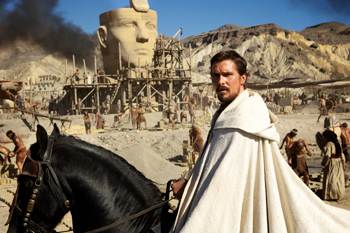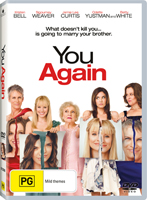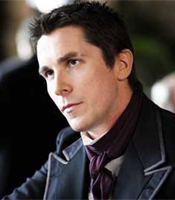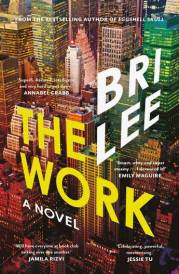Christian Bale Exodus: Gods and Kings
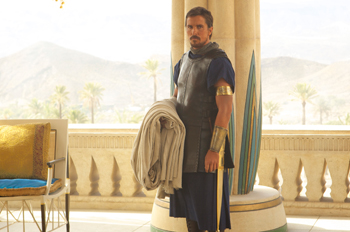
Christian Bale Exodus: Gods and Kings
Cast: Aaron Paul, Christian Bale, Sigourney Weaver
Director: Ridley Scott
Genre: Drama
Rated: MA
Synopsis: An account of Moses' hand in leading the Israelite slaves out of Egypt.
Exodus: Gods and Kings
Release Date: December 4th, 2014
About The Production
The Players
The cast of Exodus: Gods And Kings is comprised of numerous award winners, and hails from a wide range of countries. As Ridley Scott explains, 'Egypt was – as it is now – a confluence of cultures, as a result of being a crossroads between Africa, the Middle East and Europe. We cast actors from different ethnicities to reflect this diversity of culture – from Iranians to Spaniards to Arabs. There are many different theories about the ethnicity of the Egyptian people, and we had many discussions about how to best represent the culture. In bringing to life a story that has roots in many religions and is important to people across the world, we also looked to cast actors who could, through their vivid performances, do justice to a universal story."
Christian Bale stars as Moses, alongside Joel Edgerton as Ramses, John Turturro as Seti, Ben Kingsley as Nun, and Aaron Paul as Joshua.
Christian Bale is an actor with whom Scott has long sought to collaborate. 'Christian Bale has a very powerful physical presence on screen," he notes. Before shooting Exodus: Gods And Kings, Bale had starred in the Scott Free production Out of the Furnace, playing a steel worker. To Ridley Scott, that role, in a way, presaged the actor's turn as the Hebrew prophet and liberator. 'Moses is much more like a steel worker than a Pharaoh – he's a modest man with common sense."
Ridley Scott describes Christian Bale's performance as 'an inside job. He gets right into the character and you are staring at a passionate leader. I enjoyed working with Christian Bale as much as I have with anyone; he surprised me every day. I expected a lot, and I got more." There was certainly much to explore with the character. 'Moses is an iconic figure who at the same time has to be played as a real person," says Ridley Scott. 'He's the film's heroic center and its emotional core."
Christian Bale took on the role for several reasons. He explains: 'I feel the Exodus story is not only one of the cornerstones of many of the world's sacred texts, but it is one of the most profound narratives in human history. I found that Moses was a complex and reluctant hero. Through his faith he transformed into a freedom fighter who would stop at nothing to further God's will. That said, he was also a man of contradictions: He was faithful but also argumentative; hesitant but also assertive; a warrior but also a liberator; and he was tempestuous but stoic."
In short, adds the actor, 'Moses is one of the most fascinating characters I've ever studied." To that end, Bale read the holy texts, including the Torah and parts of the Koran, as well as the acclaimed book Moses: A Life by Jonathan Kirsch. He also watched two films whose approach to history and religion is very different from Exodus: Gods And Kings'. 'To get a humorous perspective before tackling this epic film I watched the comedies History of the World, Part I [directed by Mel Brooks] and the Monty Python classic The Life of Brian."
The central relationship of Exodus: Gods And Kings is between Moses and Ramses, who grew up as brothers. Ramses becomes Pharaoh and Moses his most trusted advisor and second in command. But when Ramses learns that Moses is actually a Hebrew, he expels his 'brother" into the desert and to an almost certain death. 'Ramses personifies how absolute power corrupts absolutely," says Joel Edgerton who takes on the role. 'Ramses starts to believe he actually is a god, which creates a wonderful dynamic between Moses and him."
Ramses is the story's principal antagonist, but Ridley Scott and Joel Edgerton wanted to give the character nuances and complexities that transcend stock villainy. 'Ramses has a strong , brotherly connection to Moses, so he's very conflicted when Moses is revealed to be a Hebrew. He also loves his wife Nefertari, and his young son, so that gives him important emotional shadings," says the director.
Ridley Scott first encountered Joel Edgerton years earlier, while casting his Crusades epic, Kingdom of Heaven. The actor was deemed too young for the role then, but Scott continued to follow Joel Edgerton's career, particularly his work in the acclaimed independent drama Animal Kingdom. 'Joel Edgerton has flair, and he's athletic, brooding, intellectual and very warm as well. He transposed himself elegantly into the demeanor of an Ancient Egyptian, acknowledging the period, without it feeling like -period.' Ramses is a bad guy, with good emotional parts to his character, so that you are not sure whether to hate him or not. Joel Edgerton is also very physical, so he provides a real sense of action and fury when needed." Christian Bale hails Joel Edgerton's 'tremendous commitment to the role. I felt he had one of the most difficult parts in the film. Joel Edgerton captures all the arrogance of someone with limitless power, and all the insecurities of someone desperately trying to hold onto his position."
Joel Edgerton relished the role, especially its complexities. 'The most fascinating villain is someone who, in their own movie, would be the hero," he explains. 'I always feel if you can understand the bad guy, you can cheer for the hero even more. So I wanted to find that balance between doing my job as the villain of the piece, but give him humanity. Amidst all the epic scenes of warfare, the big conflict here is the battle of wills between Ramses and Moses."
Joel Edgerton admits that Ramses has a huge ego, as expected from someone brought up to believe he is a living god. 'He is unreasonable and lacks empathy," says the actor.
'Ramses is a tyrant and a dictator, but that was part of the beliefs of the times." Ramses begins to build his own city, Pi Ramses, and adorns it with his likeness, as was the custom of the times. A huge statue head of Ramses – built by the production and modeled after Edgerton, himself – watches over the fields where the slaves work. At fifty feet high, the statue became something of a local landmark for the duration of the shoot.
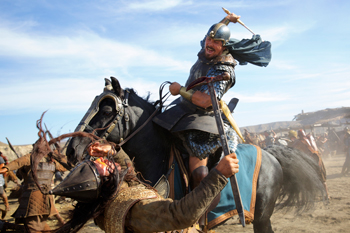 Sigourney Weaver is Tuya, mother of Ramses, first wife of Pharaoh Seti. Star of the director's seminal film, Alien, Weaver later worked with Ridley Scott on the historical epic 1492: Conquest of Paradise. She says of reuniting with Ridley Scott: 'It feels like no time has passed at all. I still see this brilliant man, in command of how to make his vision on screen."
Sigourney Weaver is Tuya, mother of Ramses, first wife of Pharaoh Seti. Star of the director's seminal film, Alien, Weaver later worked with Ridley Scott on the historical epic 1492: Conquest of Paradise. She says of reuniting with Ridley Scott: 'It feels like no time has passed at all. I still see this brilliant man, in command of how to make his vision on screen." Of her role, Sigourney Weaver notes that, 'It's been hard for Tuya to watch Moses be Pharoah Seti's favorite," Sigourney Weaver continues. 'Ridley Scott refers to her as a panther, and although Tuya could be viewed as evil, to me she is a very good mother. Tuya knows how much support Ramses needs, even though he won't admit it. Ramses loves Moses and struggles to do the right thing by him, but he and Tuya are unnerved by Moses' closeness with Pharaoh Seti. People may see Tuya as a bit of a villain but she is not. She is protecting her son."
Tuya's strength and force of will reflect the empowerment of Egyptian women of that period. 'They were really into power and beauty," says costume designer Janty Yates. 'Ridley Scott wanted Tuya to be totally -va-va-va-voom.' Tuya's costumes underscore her bold ambitions for her son. We reflected that in her headdresses and over the top jewelry."
John Turturro portrays Tuya's husband, Seti – ruler of Egypt, father to Ramses and father figure to his nephew Moses. 'Seti has held power for too long, and that's a burden for him," says the acclaimed actor. 'He has a closer relationship with Moses than with his own son, Ramses, and he would have preferred that Moses take his place as Pharoah, but Seti knows this cannot happen."
Ben Kingsley is Nun, a Hebrew scholar and spiritual leader of the slaves. Says Ridley Scott: 'Nun unmasks Moses with the truth, and starts the chain of events that leads to his exile."
Ridley Scott feels lucky to cast Ben Kingsley, who several years ago played Moses in a television miniseries. 'Ben Kingsley is a chameleon, clever and adept. There is an iron-cast center to him that was perfect for the role."
Aaron Paul's role in the landmark television series Breaking Bad earned him legions of fans, and a Primetime Emmy® Award. As the show reached its conclusion after six seasons, he was approached to play Joshua, a Hebrew slave who helps Moses lead the Hebrews out of Egypt.
Ridley Scott, who is a Breaking Bad fan, met Aaron Paul for the first time when the actor flew from Los Angeles to London for 24 hours of hair and makeup tests – before flying back overnight to attend the Emmy Awards. 'Ridley Scott has so much energy and he believes the story he is telling in all his movies," says Aaron Paul. 'That's what makes him such a powerful director; you listen to him talk and these worlds exist, whether it's Alien, Blade Runner or Exodus: Gods And Kings."
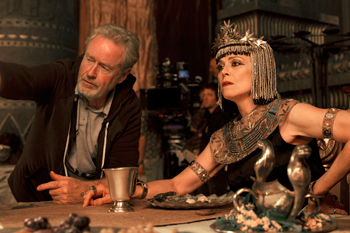 Joshua is first seen as a young slave, being punished in the brutal environs of the Egyptian brickworks. Years later, Joshua is among the first to join the guerilla band formed by Moses when he returns to try to free the slaves. 'Joshua has been brutalised for many years; that's his place in the pecking order in Egyptian society, so he is ready to join Moses and fight for freedom." Having no real weapons, Moses' band of fighters relies on bow and arrow for attack. Paul had archery and riding lessons to prepare for the shoot.
Joshua is first seen as a young slave, being punished in the brutal environs of the Egyptian brickworks. Years later, Joshua is among the first to join the guerilla band formed by Moses when he returns to try to free the slaves. 'Joshua has been brutalised for many years; that's his place in the pecking order in Egyptian society, so he is ready to join Moses and fight for freedom." Having no real weapons, Moses' band of fighters relies on bow and arrow for attack. Paul had archery and riding lessons to prepare for the shoot. 'Aaron Paul brings a freshness to the role of Joshua," Ridley Scott notes, 'and he just slipped into character and into the period seamlessly. '
Plagues And The Parting Of A Sea
When Ramses rejects Moses' pleas to let the prophet's people go, Egypt is hit by a series of plagues and pestilences. Ramses' advisors offer science-based explanations for the phenomena –spectacles that are both thrilling and horrifying.
The first of ten plague comes after crocodiles in the Nile begin attacking each other, along with several seafaring Egyptians, in a vicious feeding frenzy. The bloody, roiling water turns the Nile red, leading to a carpet of dead, oxygen-deprived fish floating atop the surface. Frogs swarm over the city of Pi-Ramses, and even into Ramses' palace, searching for food.
Four hundred frogs were called to set, with six frog handlers, a frog handler dog and a one meter high frog fence. In this scene, Golshifteh Farahani, playing Nefertari, showed her bravery over several takes by pretending to be asleep, knowing that a large bag of live frogs was being emptied over her head, and becoming entangled in her long hair.
After the amphibians die, flies swarm from their rotting, maggot-filled bodies, and the streets of the city Ramses has built in tribute to himself becomes invisible through a black curtain of flies. Says visual effects supervisor Peter Chiang: 'We took the plagues to a new and different kind of level. The flies become very distinctive and thick in their movements, and [the subsequent invasion of] locusts become even more troubling in the way they move and swarm."
Next, lesions and boils mar the bodies of almost all Egyptians. Night brings hailstones the size of rocks, followed by a massive swarm of locusts.
Laws of nature, taken to their extreme – and perhaps with divine intervention – can explain these plagues, but the final scourge transcends nature: The firstborn sons of Egypt are killed overnight, including the Pharaoh's own child. When Ramses realises that no Hebrew slave children have died, he orders them to leave Egypt – but shortly thereafter leads his army to pursue and kill the fleeing Hebrews.
Moses and his ill-equipped band of 400,000 followers, loaded down with whatever meager household goods they could carry, struggle to cross the foreboding mountains, heading for the Red Sea and to a crossing area that Moses had used before.
Arriving at the Red Sea, with the Egyptian army close behind, Moses realizes he has taken the wrong route and missed the shallow waters. Faced with the massive body of water on one side, and the thousands of Egyptian troops on the other, Moses despairs. As Ramses prepares for his final assault, Moses realizes that the tide is receding at a rapid pace. He rallies his people and they begin to stumble through the shallows. When the Hebrews complete the crossing, Ramses' pursuing troops are engulfed by a massive wave.
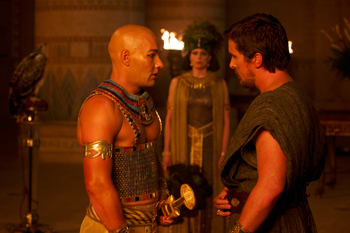 Designing And Building A World
Designing And Building A World Ridley Scott's creative collaborators on Exodus: Gods And Kings include two-time Oscar-nominee production designer Arthur Max and Academy Award® winning costume designer Janty Yates, each of whom has worked on nine previous Ridley Scott-directed films, including Gladiator and Prometheus. 'The idea of building a universe is always appealing," says Ridley Scott. 'What's so attractive about world-building on film is that anything goes, as long as it is real. I'm an architect at heart, and so is Arthur Max."
Arthur Max says Exodus: Gods And Kings is the biggest production he has ever worked on. 'The scale is epic, because that's what Ancient Egypt was, and we wanted to do it justice." he explains. 'Of course, it's never big enough for Ridley Scott, which is why we have visual effects."
Visual effects supervisor Peter Chiang elaborates: 'The visual effects are grounded in reality. Arthur Max and Ridley Scott designed amazing and expansive sets that provided a brilliant springboard for the VFX. It was good to see real lighting on an actual set, which would ultimately inform the look of our CGI."
The art and construction crew numbered over one thousand, working in three locations. The Pinewood stages housed the interiors of the lush palaces and temples of the Egyptian royalty, as well as the sparse slave hovels. The huge exterior of Pharaoh's Great Hall was filmed on the mammoth backlot, where scenes were captured of the Egyptian army setting off to fight the Hittites, and later, during their bloodied but triumphant return. The stage's paddock tank was transformed into the River Nile, turning red as fierce crocodiles cannibalize each other. Scenes of the Red Sea turning into a massive parting of the sea, drowning hundreds of Egyptian soldiers, were filmed in the underwater tank.
The production used a pulley system devised on Gladiator to quickly arrange huge statues, columns and pieces of walls, leading Ridley Scott to call it a giant LEGO-like set.
After completing work at Pinewood, the production moved to Almeria in Southern Spain, taking over a large plain in Alhamilla, in the shadow of the Sierra Madre Mountains. This dry desert area was also used in several of the Westerns directed by Sergio Leone, as well as in the landmark Lawrence of Arabia and in Raiders of the Lost Ark.
'Working in Alhamilla is like having your own huge back lot." says Arthur Max. 'The area is bigger than the 20th Century Fox back lot in California." On a plain measuring 1 by 1.5 kilometers, the central line is an avenue of palm trees. Many of these were already in place, but the production replaced those that were diseased, and all the trees needed nurturing and augmenting. The production also installed a water tank, and built the exteriors of Egyptian palaces and villas, and a street of ordinary Egyptian homes and merchants. The city of Pi Ramses and the surrounding slave ghetto were united by the avenue of palms. In addition, the brickworks supplying the new city were a short distance away.
The Battle of Kadesh, in which Ramses and Moses lead the Egyptians to victory over the Hittites, took place nearby. The actual battle was hailed as the biggest military action ever fought, with thousands of soldiers and hundreds of chariots fighting in the blazing sun.
The sequence was shot over five days, with hundreds of extras, stuntmen, animals and chariots on set, alongside five cameras and two crews – interrupted only by a huge storm which swamped the area in water, cutting of many of the crew from the road, and which the local media called 'biblical" in its scale.
A few days later, following a sunset so spectacular that it was filmed for inclusion in the movie, a sandstorm blew up on the plain of Alhamilla, damaging sets and blinding cast, crew and extras.
Fuerteventura, one of the Canary Islands off the coast of Africa in the Atlantic Ocean, was another key location. Wide empty sandy beaches, fringing high volcanic rock mountains made the island the perfect location for the Hebrew flight from Egypt in the Sinai desert. 'Parts of Fuerteventura are almost prehistoric looking; they're untouched," says Bale. 'It's one of the most stunning locations I've ever seen."
High in the mountains is the mining town of Macael, from which marble has been extracted since the time of the Phoenicians. The marble quarry appears as a slave workplace, where Moses first encounters Nun. Moses passes through again, on his way to confront Ramses with his request to free the slaves. Traveling by night, he observes the slaves, driven by cruel masters, toiling by torchlight, and hauling huge blocks of marble up mountains.
In addition to finding and building locations, Max and his team took on the enormous task of furnishing and decorating the spaces. 'You can't buy anything Ancient Egyptian, so every single item and embellishment had to be designed and made." he explains. Referencing materials in the British Museum and the Museum of Cairo, Max used a mixture of old techniques and modern technology.
The palaces were furnished with thrones and chairs, based on ancient frescoes. The production built statues from modern lightweight materials for ease of moving, but finished and aged them using ancient techniques.
The design team consulted experts in the fields of hieroglyphics, language and ritual behavior, and looked at Victorian era romantic painters of England and France, who brought intimate scenes to life. 'The film reflects an eclectic mixture of influences, which we think will maximize the grandeur that was Ancient Egypt, alongside the suffering and deprivation that accompanies slavery," says Arthur Max.
Arthur Max describes Ridley Scott's exacting working methods with his creative department heads. 'We sit round a table and go through the script page by page, using visual references. When we visit locations, different ideas are thrown up, and also come from the work of other departments. Ridley Scott always surprises us by taking a direction none of us have thought of. The characters and their environment, and how they interact, come from his mind; it's his vision of their world. Ridley Scott draws beautifully, so you have to keep track of whatever he has just produced, which is sometimes on the back of somebody's script. If you have a good idea, he makes it better. And he finds the best position on any set, sometimes an angle nobody else has thought of. As well as being an artist, he is a cameraman and a very quick study in modern technology, grasping what's going on, and how he can use it.
'It's like working for a Renaissance Master; we are his pupils, implementing his vision of how he wants it to be seen on screen," says the production designer.
Janty Yates won the Academy Award for Best Achievement in Costume Design for her work on Gladiator, and has collaborated with Ridley Scott on six other features. She views this collaboration as the ultimate challenge. 'Ridley Scott is a painter, and he is an inspiration. Watching him set up a shot, no detail escapes him. It's exciting to experience because you know every frame is going to be special."
The basis of Janty Yates' design is research and, as she points out, she was lucky that so much reference is available, recorded in the art of Ancient Egypt, on walls and statues. 'For Gladiator, nothing much was available online, so a lot of time was spent wandering around Rome, looking at statues for guidance."
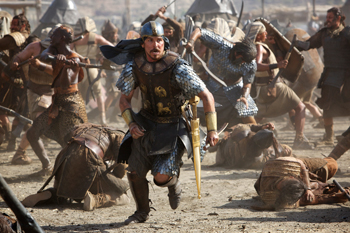 For Janty Yates, her most exciting discovery during her prep work was how advanced the Egyptians were in fashion and design. 'The jewelry in particular is made with such craftsmanship, so detailed and delicate," she says.
For Janty Yates, her most exciting discovery during her prep work was how advanced the Egyptians were in fashion and design. 'The jewelry in particular is made with such craftsmanship, so detailed and delicate," she says. The scope of the film is enormous and Janty Yates and her associate costume designer, Stefano de Nardis, set up a factory in Ouarzazate in the Moroccan desert, bringing together cutters, seamstresses, embroiderers, metal workers, shoemakers and jewelers to create the costumes for the Egyptians, the army, the Hittites, the palace guards and some of the specially featured players. Each of the twenty principal cast members had many elaborate costumes, with multiple details, and often had to have eight or nine repeats of one costume, so Janty Yates additionally set up a huge organization of dyers, cutters, and other specialists, in London.
Dressing Moses was the most complicated undertaking. "He has several looks," Janty Yates explains. 'In the first one, Moses is a young prince of Egypt, loved by Seti, close to his cousin Ramses and distrusted by Tuya. Ridley Scott wanted him to be discreet, in this court of flamboyance. He is primarily a military man, so he has sober tones, neat clothes, and is almost clean cut, with short-ish hair."
In the second act, wandering in the desert, he looks like a vagabond, and after being attacked by some tribesmen, he wears their clothes. When he meets his future wife Zipporah and settles down, he is a shepherd, in the countryside. Then when he decides to return to Egypt to confront Ramses, he is the guerrilla warrior, living in the mountains with his posse and eventually leading his people to freedom."
While acknowledging the challenges of dressing the ever-evolving Moses, Janty Yates notes that her favorite creations are the outrageous costumes worn by Ramses. 'In a sea of Hittites, or in amongst some rather grubby Egyptian soldiers, Ramses' gold outfit and armor have that -wow' factor. And Joel Edgerton wears it so well. Every time I dressed him, I just fell in love with the look."
As Ridley Scott puts it, Ramses wears a lot of bling. Joel Edgerton quickly became accustomed to his character's preference for gold and was heard to joke, 'I'm not having that …unless it's gold," or 'bring me my gold skirt - the number seventy six."
Says Janty Yates: 'Ramses was arrogant, erecting more statues to himself than any other Pharaoh, so everything he has reflects that personality. It literally reflects, in that it is all gold, including jewels, helmet and clothes. Seti is gilded but not flamboyant like his son, while Tuya is both flamboyant and sexy. Tuya expects to be Queen of the country when Ramses takes over, so she is gearing herself up for that role in the public eye."
Zipporah, whom Moses marries in a village far from Egypt, is, says Janty Yates, 'young, fresh, beautiful and modern, so her clothes reflect that; she is a working tribeswoman."
Zipporah, portrayed by Maria Valverde, is a physically striking character, thanks in part to makeup department head Tina Earnshaw, an Oscar winner for her work on Titanic and who collaborated with Scott on Prometheus and The Counselor. Earnshaw gives Zipporah black coal for her eyes, facial tribal tattoos and Henna tattoos on her hands, arms, feet and legs. 'She just looks beautiful at all times," says Tina Earnshaw.
Every costume, prop, design, structure and visual effect speaks to the film's epic scale. But as Ridley Scott notes, the sensibilities of Exodus: Gods And Kings are always grounded. 'Moses grew up as an important Egyptian noble –a Prince of Egypt –with some very real human insecurities and questions."
For Christian Bale, portraying Moses was an unforgettable experience. 'He's such an intoxicating character to play, that in many ways I felt like, -Wow, can't we keep going?' There is so much more to tell about him, and he's even more fascinating than anything I had realised."
Exodus: Gods and Kings
Release Date: December 4th, 2014
Have You Seen This?
MORE
- Mission: Impossible Fallout
- Glenn Close The Wife
- Allison Chhorn Stanley's Mouth Interview
- Benicio Del Toro Sicario: Day of the Soldado
- Dame Judi Dench Tea With The Dames
- Sandra Bullock Ocean's 8
- Chris Pratt Jurassic World: Fallen Kingdom
- Claudia Sangiorgi Dalimore and Michelle Grace...
- Rachel McAdams Disobedience Interview
- Sebastián Lelio and Alessandro Nivola...
- Perri Cummings Trench Interview

